Coastal salmon fisheries off to decent start, coho mostly a no show; and early Lake Washington sockeye counts are soaring 1
The coastal salmon fishery started off on a high note this past weekend at Ilwaco, La Push and Neah Bay, and many are also gearing up for the Westport opener this coming Saturday.
“What we’re seeing at Ilwaco is interestingly all chinook in the catch, and a lot of people with their one-chinook (daily) limit,” said Wendy Beeghly, the head state Fish and Wildlife coastal salmon manager. “People are having trouble finding coho. I heard up north they’re seeing more chinook than coho although they did have coho in the catch, plus some pinks which is pretty early.”
Beeghly said the average catch was a fish per person at La Push and Neah Bay or could even be a little higher after all the data is tallied. The average size at La Push, Neah Bay and Ilwaco was 8 to 12 pounds with some bigger ones too.
“It is not great weather conditions, but not terrible although it might get worse during the week,” Beeghly said. “Apparently we’ve got windy weather coming (northwest winds are forecasted at 15 to 25 mph Monday through Wednesday).”
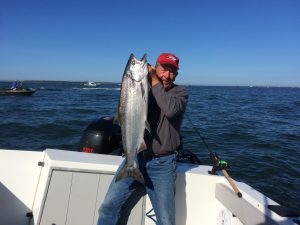
Clyde McBrayer of Olympia holds a 25-plus pound king caught in the ocean off Ilwaco that was bound for the Columbia River.
A Columbia River fall chinook forecast of 582,600 resembles last year’s actual return (951,300 was forecast last year with an actual return of 643,300), and was the fourth largest on record although down significantly from record runs in 2013 to 2015.
“We’ve had some strong chinook returns in past years, and those are the bread-and-butter of our fisheries,” Beeghly said. “The Columbia chinook returns look slightly below average. I would expect coho returns to be OK and nothing on fire.”
Ocean king fisheries will be driven by a lower river hatchery chinook stock of 92,400 and Bonneville Pool hatchery chinook stock of 158,400 – better known as “tule chinook” – that are mainly caught off Ilwaco, Westport and later in summer at Buoy 10 near the Lower Columbia River mouth.
The tule are a lower river hatchery run is close to recent five-year average, and Bonneville Pool hatchery run is predicted to be the second highest return since 2004.
The all-time actual return record dating back to 1938 was 1,268,400 adult chinook in 2013, up from 227 percent of the 2003-to-2012 average of 557,600 adult fish. In 2014, the actual return was 1,159,000, which was second-highest on record.
On the table this summer is a sport chinook catch quota of 45,000 fish, which is 10,000 more fish than 2016’s quota of 35,000 chinook. A quota of 42,000 hatchery-marked coho for this summer’s sport fishery is about 23,100 more fish than last year’s quota of 18,900 coho.
The Ilwaco catch quota is 21,000 hatchery-marked coho and 13,200 chinook; Westport is 15,540 hatchery-marked coho and 21,400 chinook; La Push is 1,090 hatchery-marked coho and 2,500 chinook; and Neah Bay is 4,370 hatchery-marked coho and 7,900 chinook.
The ocean non-tribal commercial troll fisheries opened in May, and after a lull during the brief season it recently started to show signs of life.
“The troll fishery slowed way down for about three weeks, and that is not all uncommon to see, but just this past week it really started to pick back up,” said Beeghly. “It looks like a new batch of fish are coming through, and we’ve seen some bigger fish up north (off Neah Bay).”
Ilwaco, La Push and Neah Bay are currently open for salmon fishing, and Westport opens Saturday (July 1). Fishing will remain open daily at all four coastal ports through Sept. 4 or until quotas are caught, whichever comes first.
The daily limit at Neah Bay and La Push is two salmon of either chinook or hatchery-marked coho. The daily limit at Westport and Ilwaco is two salmon, but only one may be a chinook. The chinook minimum size limit is 24 inches and the hatchery-marked coho minimum size is 16 inches.
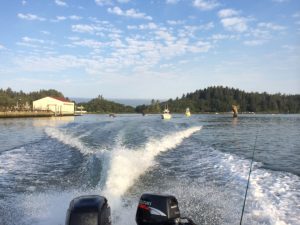
The entrance to the Port of Ilwaco will be one of the areas that takes center-stage this summer for thousands of salmon anglers trying their luck off the coast.
Catches weren’t great last summer with an average at Westport of 0.81 chinook per rod during the first week of August; 0.49 at Neah Bay; 0.10 at La Push; and 0.56 at Ilwaco.
Many overlook premier summer king fisheries off La Push and Neah Bay. Make plans to trek in mid-July to La Push and Neah Bay where kings and other salmon species either head into the Strait of Juan de Fuca or continue their journey south along the coast.
The trend in recent years for kings occurs along the 30-foot line just outside the surf in the ocean off Long Beach near the Cape Disappointment Lighthouse. This is a relatively easy place to fish when ocean conditions allow with anglers letting out 13 to 15 pulls of line (two feet per pull) with a diver or Fish Flash and a whole or cut-plug herring.
The best time off Long Beach is August as salmon stage before moving into the Columbia River, and it doesn’t matter on the tide or time of day as long as the fish are holding. On the surf line look for huge anchovy baitfish schools.
NOTE: A lesson learned last summer was if the fish aren’t showing at Long Beach don’t waste too much time plowing an empty field. We moved south just about five miles, and payoff turned out to be money in the pocket.
As the summer progresses in late summer and early fall salmon fishing will shift to the Buoy-10 area at the mouth of the Columbia River and up and beyond the Astoria-Megler Bridge.
The Buoy-10 king salmon season is open Aug. 1 through Sept. 4 then shifts to coho only from Sept. 5-30. Look for this to blossom by the middle of August although in past years the fish have shown up right from the start.
The Desdemona Sands (a flat sandy bar which is exposed at low tides) is a place to look at during a mid- to late-flood tide as fish move along the drop-offs. Many will also work the buoy line on the Oregon side up to the bridge, which has also become a very popular area.
In the early morning on a flood tide, plan to first stop along the Wing Walls – located outside of the Port of Ilwaco – and work your way up and down the river.
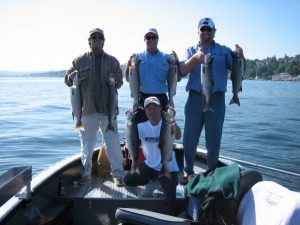
Anglers are still holding out hope that a Lake Washington sockeye fishery will occur later this summer. Pictured are a group of anglers who had luck in the south-end of the lake during the last time a fishery occurred in 2006.
Nibbles and bites
Lake Washington sockeye returns are off to a really robust start, but many are under cautious optimism since this is just the early stages with the peak of the run occurring around July 4.
“It is off to a strong start, but when you look at the run two years ago they came in early and it seemed like a big run only to eventually even out at the end,” said Aaron Bosworth, a state Fish and Wildlife biologist. “My suspicion is we’re on track for something like that, but it is still too soon to know. It could be as high as 190,000, but that could change dramatically as we move forward.”
Total so far this season is 29,760 slightly ahead of 29,159 in 2006 when the last sport fishery occurred. Pre-season forecast was 77,292.
Single-day counts were: 3,482 on June 25; 2,797 on June 24; 4,342 on June 23; 2,230 on June 22; 2,071 on June 21; 2,448 on June 20; 2,563 on June 19; 1,964 on June 18; 2,124 on June 17; 2,039 on June 16; 1,359 on June 15; 1,201 on June 14; 352 on June 13; and 728 on June 12.
Fishery workers have been collecting samples of sockeye at the Locks, and had no problem gathering their 200 fish.
“The fish are in really good condition, and there seems to be a lot of large five-year-old fish,” Bosworth said. “Last year we were supposed to see more big fish, but we didn’t, and maybe they stayed in the ocean as age four fish and are now coming back as age five fish.”
The outgoing fry migration of this summer’s adult returning fish was an above average number of both wild and hatchery produced sockeye fry.
The spawning goal is 350,000, but recently fisheries managers have agreed if the run exceeds 200,000 then they could possibly open a fishing season on the state’s second largest freshwater watershed. Keep your fingers crossed on this one!
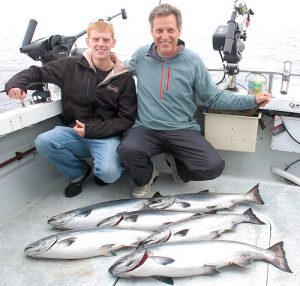
John Martinis owner of John’s Sporting Goods in Everett and his son kneel besides a nice catch of hatchery kings.
The Strait of Juan de Fuca from Sekiu to Port Angeles opens for hatchery kings on Saturday (July 1) through Aug. 15, and last summer the eastern portion got off to a hot start.
“We had some spectacular days around Port Angeles when it opened last summer, and I’ll be there for the opener,” said Tony Floor, the director of fishing affairs for the Northwest Marine Trade Association.
Sekiu in the western Strait will remain open from Aug. 16-31 for a fishery that targets mainly pinks and hatchery-marked coho.
While there won’t be a bonus catch limit for pinks, anglers in the eastern Strait can keep two additional sockeye salmon in a daily limit. The problem is you’ll need to figure out how to catch them as they’ve been rather tricky to get to bite. Commercial trollers in the ocean have success using bare red hooks or small hootchie rigs has been the new “go to” way when fishing in places like Baker Lake.
The Army Corp of Engineers made a mistake (and we are all entitled to those) on the Columbia River shad count at Bonneville Dam on June 19 as a malfunction in their counting system tallied the wrong figure.
They revised the total single-day from 497,738 to 247,366. That’s still not a shabby daily count, just not the near record proportions as originally thought. That was followed by another 246,596 shad on June 20, and 148,872 on June 21. That brought the total season count to 1,310,094. The highest single-day counts were in 2003 with 506,724 on June 5 and 520,664 on June 6.
Fishing off the Washington bank just below Bonneville Dam has been excellent. Some groups of anglers last week had close to a hundred fish when sampled. Fish are reported to be good sized. A popular fishing location, Steamboat Landing Dock in Washougal, is closed and will be opened in the future after repairs are made.
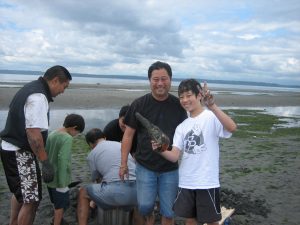
The elusive geoduck like this being held by Taylan Yuasa can be found on many beaches of Puget Sound and Hood Canal especially during extreme low tides during summer.
The most extreme low tides of the summer are happening right now, and that means Puget Sound shellfish seekers targeting the elusive deep-dwelling geoduck should find excellent opportunities as well as for a variety of other clams and oysters.
Low tide: Monday, minus-3.0 feet at 1:05 p.m.; and Tuesday, -2.2 at 1:53 p.m. Next series of low tides are July 7, -1.0 at 9:10 p.m.; July 8, -1.3 at 11:07 a.m.; July 9, -1.4 at 11:42 a.m.; July 10, -1.5 at 12:17 p.m.; and July 11, -1.3 at 12:54 p.m. Those will be followed by even more lower tides on July 20, -1.5 at 8:48 a.m.; July 21, -2.4 at 9:39 a.m.; July 22, -2.8 at 10:27 a.m.; July 23, -3.0 at 11:15 a.m.; July 24, -2.7 at 12:01 p.m.; -2.1 at 12:47 p.m.; and July 25, -1.1 at 1:32 p.m.
Diggers should note that all eastern mainland beaches from Everett south into southern Puget Sound are also closed for shellfish due to unsafe pollution levels. Before heading to a beach, call the marine biotoxin hotline at 800-562-5632 or visit the website at www.doh.wa.gov. Also check the state fisheries hotline at 866-880-5431 and website at http://wdfw.wa.gov. State Fish and Wildlife offers a good interactive shellfish map at http://wdfw.wa.gov/fish/shelfish/beachreg.


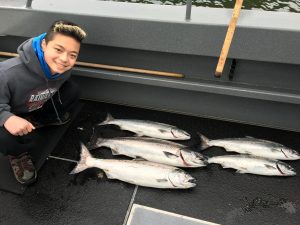
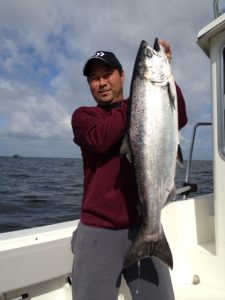
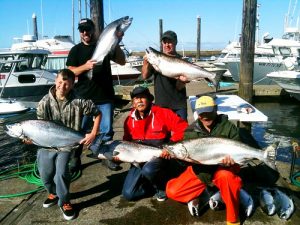
Missed reading your articles on Thursdays! Decided to find out why. Glad to find out about your blog.